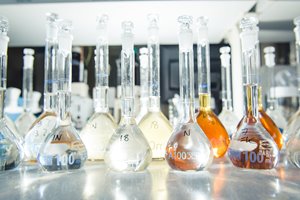Wood
Studies of Wood Properties - Important for Process and Final Product
By studying wood, one can obtain insights crucial for answering several important questions within the pulp and paper industry. One of these questions is whether it is possible to introduce new wood species into production while maintaining the desired properties of the resulting pulp.
Understanding how different wood species interact with existing processes and how their chemical composition affects the final product is crucial for making informed decisions about the use of new raw materials.
Another question under investigation is how much of a specific wood species can be blended into the pulp without compromising the quality of the resulting mass. This entails determining optimal blending ratios to achieve desired properties of the pulp while efficiently utilizing available resources and minimizing waste.
Furthermore, it is also of interest to examine the effects of changes in chip size on the chip mixture. By modifying chip size, one can influence the distribution of different fractions within the chips, which in turn can have implications for the structure, strength, and other important properties of the pulp. Therefore, it is necessary to evaluate how different chip sizes affect process efficiency and the quality of the final pulp to optimize the production process and ensure consistent product quality.
In RISE's pilot cooking facility, we have the ability to use up to six input baskets to keep different wood species or chip fractions separated throughout the cooking process. This means that we can conduct cooking of up to six different raw materials or chip fractions in the same cooking step and under the same conditions, providing unique flexibility and opportunities for detailed experiments.
After defibration, we can analyze yield, kappa number, viscosity, rejects, chemical composition, and physical properties separately for each pulp or for different blends, entirely according to the customer's specific needs and requirements. One of the most important properties to study is the physical dimensions of the chips, especially in kraft cooking where chip thickness is crucial to achieve optimal impregnation.
After cooking, the different pulps undergo a bleaching process to evaluate bleachability and the properties of the resulting pulps, such as strength and optical properties. With RISE's custom refiner and experimental paper machine, we can then take the investigation one step further and evaluate the paper's properties, providing a comprehensive analysis of the material's performance.
Interest in wood investigations is high for several reasons. During periods of rising wood prices, it may be of interest to explore the effects of different blends, such as including eucalyptus in birch pulp. In other cases, the focus may be on blending effects of aspen. Since both aspen and eucalyptus are easy to cook compared to birch, they absorb cooking chemicals from the birch, requiring careful control of the blending level to avoid variations in quality.
For customers in Europe, it may also be interesting to evaluate wood species such as poplar, oak, and beech, whose cookability differs from that of birch. Sometimes the process does not start with chips; we may receive the wood raw material in the form of logs that we process ourselves by debarking and chipping before cooking. This is particularly common when the customer wants to test a wood species that is not normally used and where chips cannot be taken from the existing chip yard.
Method
RISE has placed great emphasis on developing efficient methods and specialized equipment to simulate all commercially available cooking methods within the pulp and paper industry. By closely mimicking the various processes used on an industrial scale, we can create a testing environment that accurately reflects real production conditions in a precise and reliable manner.
These simulation methods and equipment enable experiments and tests of different cooking methods, including sulfate, sulfite, and neutral sulfite semichemical pulping, among others. We can tailor experiments to test various variables such as temperature, pressure, cooking chemicals, cooking time, and chip size to evaluate their impact on the properties and performance of the pulp.
By simulating these cooking methods in our laboratory environments, we can analyze and understand how different process parameters affect the composition of the pulp, the structure of the fibers, and the properties of the final products. This enables us to optimize production processes, anticipate outcomes, and address potential issues before they arise on an actual industrial scale.
RISE's commitment to developing these methods and equipment for simulating cooking methods is of great significance in supporting the pulp and paper industry's needs for efficiency, innovation, and sustainability. By providing reliable testing opportunities and expertise in this area, we contribute to advancing the industry and ensuring high-quality products and processes.
Read more and see the film Screened wood chips.
-
Mats Westin
 E-mail: mats.westin@more.se Mobil: +4670-354 09 44
E-mail: mats.westin@more.se Mobil: +4670-354 09 44
